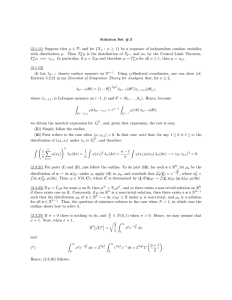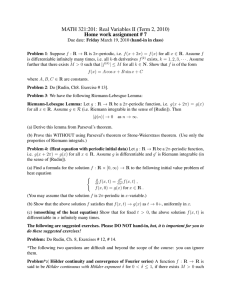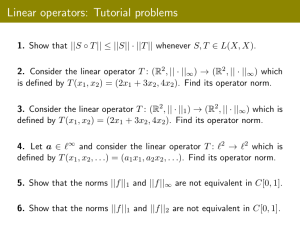ON THE LOCAL H ¨ OLDER CONTINUITY OF THE INVERSE OF THE
advertisement
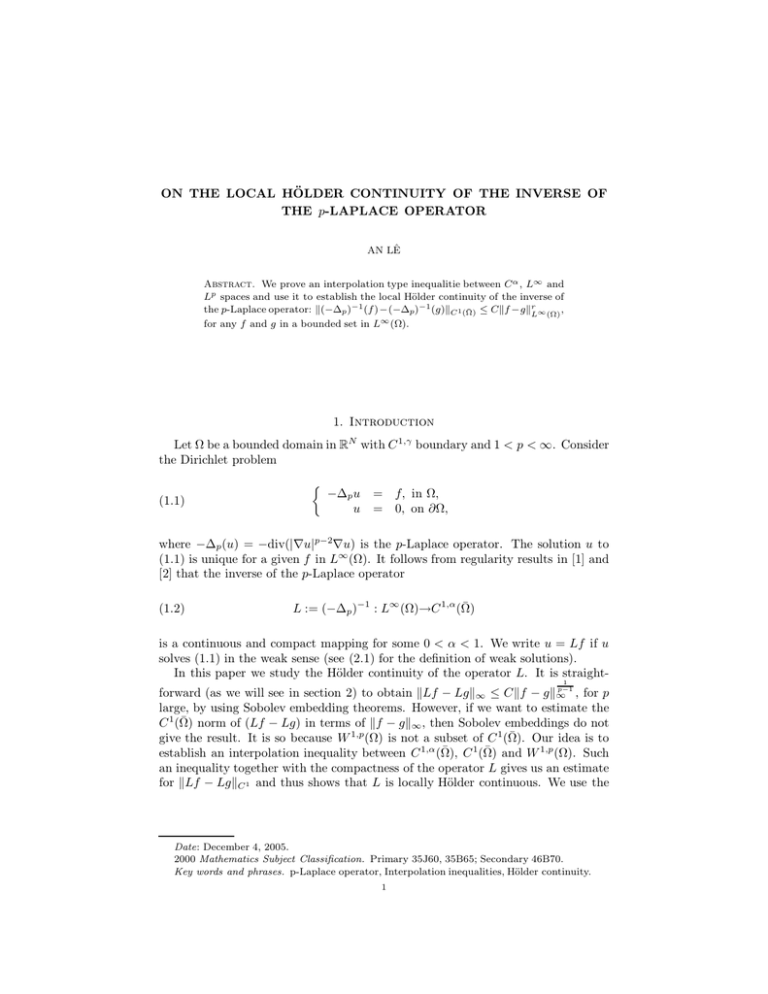
ON THE LOCAL HÖLDER CONTINUITY OF THE INVERSE OF
THE p-LAPLACE OPERATOR
AN LÊ
Abstract. We prove an interpolation type inequalitie between C α , L∞ and
Lp spaces and use it to establish the local Hölder continuity of the inverse of
the p-Laplace operator: k(−∆p )−1 (f )−(−∆p )−1 (g)kC 1(Ω̄) ≤ Ckf −gkrL∞ (Ω) ,
for any f and g in a bounded set in L∞ (Ω).
1. Introduction
Let Ω be a bounded domain in RN with C 1,γ boundary and 1 < p < ∞. Consider
the Dirichlet problem
(1.1)
−∆p u
u
= f, in Ω,
= 0, on ∂Ω,
where −∆p (u) = −div(|∇u|p−2∇u) is the p-Laplace operator. The solution u to
(1.1) is unique for a given f in L∞ (Ω). It follows from regularity results in [1] and
[2] that the inverse of the p-Laplace operator
(1.2)
L := (−∆p )−1 : L∞ (Ω)→C 1,α (Ω̄)
is a continuous and compact mapping for some 0 < α < 1. We write u = Lf if u
solves (1.1) in the weak sense (see (2.1) for the definition of weak solutions).
In this paper we study the Hölder continuity of the operator L. It is straight1
p−1
forward (as we will see in section 2) to obtain kLf − Lgk∞ ≤ Ckf − gk∞
, for p
large, by using Sobolev embedding theorems. However, if we want to estimate the
C 1 (Ω̄) norm of (Lf − Lg) in terms of kf − gk∞ , then Sobolev embeddings do not
give the result. It is so because W 1,p(Ω) is not a subset of C 1 (Ω̄). Our idea is to
establish an interpolation inequality between C 1,α (Ω̄), C 1 (Ω̄) and W 1,p (Ω). Such
an inequality together with the compactness of the operator L gives us an estimate
for kLf − LgkC 1 and thus shows that L is locally Hölder continuous. We use the
Date: December 4, 2005.
2000 Mathematics Subject Classification. Primary 35J60, 35B65; Secondary 46B70.
Key words and phrases. p-Laplace operator, Interpolation inequalities, Hölder continuity.
1
2
AN LÊ
following notations:
α, β, γ
:
positive constants in (0, 1).
U
Ω
c, r, θ
:
:
:
an open set in RN .
an open bounded domain in RN with C 1,γ boundary.
positive constants depending only on the universal
parameters such as N, p, Ω.
c(M )
:
C α (Ū ), C α (RN )
:
a constant depending on M and possibly on
the universal parameters.
|u(x) − u(y)|
< ∞}.
{u : |u|α := sup
|x − y|α
x6=y
kukC 0,α = kuk0,α
=
kuk∞ + |u|α .
:
=
{u : ∇u is continuous}.
k∇uk∞ + kuk∞.
1
1
N
C (Ū ), C (R )
kukC 1 = kuk1,0
We denote by k · k1,α and k · kq the norms in C 1,α and Lq , 1 ≤ q ≤ ∞, respectively.
The spaces W01,p and W 1,p, 1 < p < ∞, are used in the standard way.
Our first result is about an interpolation inequality in RN .
Theorem 1.1. Given 0 < α < 1 and 1 ≤ q < ∞, there exist constants c and
0 < θ < 1 (depending only on N , p and α) such that for any u in C α (RN )∩Lq (RN ),
(1.3)
θ
kuk∞ ≤ ckuk1−θ
0,α kukq .
Next, we establish the inequality (1.3) for an open set U in RN . It is possible if
U satisfies the cone property (see definition 3.1).
Theorem 1.2. Let U be an open set in RN such that U satisfies the cone property.
Given 0 < α < 1 and 1 ≤ q < ∞, there exist constants c and 0 < θ < 1 such that
for any u in C α (Ū ) ∩ Lq (U )
(1.4)
θ
kuk∞ ≤ ckuk1−θ
0,α kukq .
An immediate consequence of theorem 1.2 is the interplay between C 1,α (Ū ),
C (Ū ) and W 1,p(U ).
1
Corollary 1.3. Let U be an open set in RN such that U satisfies the cone property.
There exist constants c > 0 and 0 < θ < 1 such that for any u ∈ C 1,α (Ū )∩W 1,p(U ),
(1.5)
θ
kuk1,0 ≤ ckuk1−θ
1,α kukW 1,p .
Inequality (1.5) is the key result which is used to show the Hölder continuity of
∞
the operator L defined by (1.2). Let BM
be a ball in L∞ (Ω) with radius M > 0.
∞
By compactness, the image L(BM ) is a bounded set in C 1,α (Ω̄).
Theorem 1.4. Given M > 0, then there exist positive constants c(M ) and r such
that
(1.6)
kLf − Lgk1,0 ≤ c(M )kf − gkr∞ ,
∞
for any f and g in BM
(i.e. 0 < kfk∞ , kgk∞ < M ).
ON THE LOCAL HÖLDER CONTINUITY OF THE INVERSE OF THE p-LAPLACE OPERATOR
3
Theorem 1.4 shows that the operator L, as a mapping from L∞ (Ω) to C 1 (Ω̄), is
locally Hölder continuous if 0 < r < 1 and is locally Lipschitz continuous if r ≥ 1.
The rest of the paper is organized as follows. In section 2 we recall preliminary
results and study the kLf − Lgk∞ estimate of problem (1.1). In section 3, we give
the proofs of theorem 1.1 and theorem 1.2. Finally in section 4, we establish the
Hölder continuity of the operator L by proving theorem 1.4.
2. Preliminary results
Let us recall the definition of weak solutions to problem (1.1). Given a measurable function f, we say a function u in W01,p (Ω) solves (1.1) in the weak sense
provided that
Z
Z
fvdx, ∀v ∈ W01,p (Ω).
|∇u|p−2∇u∇vdx =
(2.1)
Ω
Ω
Evidently, if f is in Lq (Ω), for any q ∈ [p, ∞] then the left hand side of (2.1) is
finite for any v in W01,p(Ω). In fact if f is a bounded function, the corresponding
solution u is unique and differentiable. The following proposition is a summary of
regularity theory of the p-Laplace operator.
Proposition 2.1. Let f be in Lq (Ω) for some q ∈ [p, ∞]. Then the exists a unique
solution u to problem (1.1), i.e. the inverse p-Laplace operator L is well-defined.
Moreover,
(i) If q > N/p, then u is in C 1,β (Ω) locally, i.e. u is of class C 1,β on any compact
subset of Ω.
(ii) If q = ∞, then u is in C 1,α (Ω̄). Furthermore, for any number M positive
there exists a constant c = c(M ) such that
kuk1,α = kLfk1,α ≤ c(M ),
whenever 0 ≤ kfk∞ ≤ M .
(iii) The operator L is continuous and compact from L∞ to C 1 (Ω̄).
We recall that a mapping is said to be compact if it maps bounded sets to
precompact sets.
Proof. The existence of a solution u can be established by minimizing in W01,p (Ω)
the functional
Z
Z
1
fudx.
|∇u|pdx −
J(u) =
p Ω
Ω
The uniqueness of u is a direct consequence of lemma 2.2. Assertion (i) is a special
case of the results proved in [1] or in [4] and assertion (ii) is shown by Lieberman
in [2]. Finally, due to (ii) the operator L maps bounded sets in L∞ (Ω) to bounded
sets in C 1,α (Ω̄). Consequently, we obtain (iii) by the compact imbedding from
C 1,α (Ω̄) into C 1 (Ω̄). In fact, L is a continuous and compact mapping from L∞ (Ω)
′
to C 1,α (Ω̄), for any 0 ≤ α′ < α.
R
Let A be the differential mapping of the functional p1 Ω |∇u|pdx,
(2.2)
A
:
hAu, vi
=
W 1,p(Ω)→W01,p (Ω)∗ ,
Z0
|∇u|p−2∇u∇vdx, ∀u, v ∈ W01,p (Ω).
Ω
Clearly, u = Lf is equivalent to hAu, ·i = hf, ·iL2 .
4
AN LÊ
In the proof of theorem 1.4 we use some properties of the operator A. In [3],
Lindqvist shows that there exists a constant c = c(p) such that for any vectors x
and y in RN , one has
|y|p
≥
|y|p
≥
|x|p + p|x|p−2 x · (y − x) + c|x − y|p , if p ≥ 2,
|x − y|2
, if 1 < p < 2.
|x|p + p|x|p−2 x · (y − x) + c
(|x| + |y|)2−p
Direct calculations yield the following:
Lemma 2.2. For any u and v in W01,p(Ω), we have
Z
hAu − Av, u − vi ≥ c(p)
(2.3)
|∇u − ∇v|p dx, if p ≥ 2,
Ω
Z
|∇u − ∇v|2
(2.4)
dx, if 1 < p < 2.
hAu − Av, u − vi ≥ c(p)
2−p
Ω (|∇u| + |∇v|)
Equalities hold if and only if u = v in Ω.
To motivate our work, let us estimate kLf − Lgk∞ . Using (2.3) in lemma 2.2
one can show that for p > N ,
1
p−1
kLf − Lgk∞ ≤ ckf − gk∞
.
(2.5)
To see this, let u = Lf and v = Lg, it follows from (2.3) that
Z
cku − vkpW 1,p (Ω) ≤ hAu − Av, u − vi = (f − g)(u − v),
0
Ω
which, by Hölder inequality, implies
cku − vkpW 1,p (Ω) ≤ kf − gk∞ ku − vkW 1,p (Ω) .
0
0
As p > N , the space
follows.
W01,p (Ω)
is compactly embedded into L∞ (Ω). Thus, (2.5)
Remark 2.3. (i) As we see the from the argument, the constant c in (2.5) does not
1
depend on f and g; (ii) Using the identity L(kf) = k p−1 Lf, for any k > 0, we can
easily see from proposition 2.1 - (ii) that there exists a constant c independent of
f such that
1
(2.6)
p−1
kLfk1,α ≤ ckfk∞
.
3. Interpolation inequalities
In this section we establish interpolation inequalities between C α , L∞ and Lq in
R and in its open subsets.
Proof of theorem 1.1. If kuk∞ = ∞, there is nothing to prove. Suppose kuk∞ <
∞, it suffices to show
N
(3.1)
θ
|u(0)| ≤ ckuk1−θ
0,α kukq .
For arbitrary y in RN , let v(x) = u(x + y) and use (3.1) to obtain
θ
|u(y)| = |v(0)| ≤ ckuk1−θ
0,α kukq ,
which implies (1.3).
ON THE LOCAL HÖLDER CONTINUITY OF THE INVERSE OF THE p-LAPLACE OPERATOR
5
To see (3.1) we first observe from the triangle inequality that
|(u(x) − u(0)| α
|x| + |u(x)|,
|x|α
|u(0)| ≤
(3.2)
kuk0,α|x|α + |u(x)|, ∀x ∈ RN .
≤
For any r > 0, we integrate both sides of (3.2) over the ball Br = B(0, r) to get
Z
Z
N
α
ωr |u(0)| ≤ kuk0,α
|x| dx +
|u(x)|dx
Br
Br
′
r N+α
kuk0,α + (ωr N )1/q kukLq (Br ) ,
ω
N +α
≤
here ω is the volume of the unit ball in RN and
Thus,
1
q′
= 1 − q1 if q > 1,
1
q′
= 0 if q = 1.
′
1
r α kuk0,α + (ωr N )−1+1/q kukq
N +α
1
≤ c(r α kuk0,α + β kukq ),
r
|u(0)| ≤
′
1
where c = max{ N+α
, ω−1+1/q } and β = N (1 − 1/q ′ ) > 0. We note that the above
inequality holds for any r > 0. We use the fact
rα a +
1
b
α
b = a1−θ bθ , if r α+β = and θ =
,
rβ
a
α+β
to conclude that
θ
|u(0)| ≤ ckuk1−θ
0,α kukq ,
α
.
with θ = α+β
The main idea in the previous proof is the integration over any ball Br , with
arbitrary radius r > 0, of both sides of inequality (3.2). Given U an open set in RN ,
we want to establish (1.4) (in theorem 1.2) by using such an idea. By translation,
we can assume 0 is in Ū and thus we obtain (3.2) for any x ∈ U . However, U may
not contain all the balls Br = B(0, r) with arbitrary radius, or U may not even
contain any ball Br at all if 0 is on the boundary of U . As we will see later, it
turns out that we only need to integrate on a fixed portion of a ball, namely a cone,
and up to a fixed radius r0 . For this reason, we assume that U satisfies the cone
property.
Definition 3.1. We say an open U satisfies the cone property if there is a cone
K(r0 ) with radius r0 > 0 such that for each point x in Ū we can place inside Ū a
cone K(x, r0 ), center at x, which is congruent to the cone K(r0 ).
Proof of theorem 1.2. It suffices to show, for any x in Ū , that
(3.3)
θ
|u(x)| ≤ ckuk1−θ
0,α kukq .
Following the argument made in the proof of theorem 1.1 we obtain
(3.4)
|u(x)| ≤ kuk0,α|y|α + |u(y)|,
for any y in Ū . Let K(x, r0 ) be the cone center at x (by definition 3.1). For any
0 < r < r0 , integrating both sides of (3.4) over the cone K(r) = K(x, r0 ) ∩ B(x, r)
6
AN LÊ
to get
ωK r N |u(x)| ≤
kuk0,α
Z
|y|α dy +
ωK
|u(y)|dy
K(r)
K(r)
N+α
≤
Z
′
r
kuk0,α + (ωK r N )1/q kukLq (Br ) ,
N +α
1
r0N
here ωK = |K(0, 1)|, the volume of
that
K(r0 ). Thus there is a constant c1 > 0 such
1
kukq ),
rβ
α
for any 0 < r < r0 . Let θ = α+β , we consider two cases.
|u(x)| ≤ c1 (r α kuk0,α +
kuk
kuk
q
q
< r0α+β . By taking r α+β = kuk0,α
and substituting into the above
(i) kuk0,α
inequality we obtain
θ
|u(x)| ≤ c1 kuk1−θ
0,α kukp .
(ii)
kukq
kuk0,α
≥ r0α+β . We note that
1−θ
θ
θ α
kuk∞ ≤ kuk0,α ≤ kuk1−θ
0,α kuk0,α ≤ kuk0,α kukq r0 .
Combining these two cases we conclude (3.3) with c = max{c1 , r0α }.
We leave the verification of corollary 1.3 to the reader.
4. On the local Hölder continuity of L
As mentioned in section 1, we assume Ω is a bounded domain in RN with C 1,γ
boundary and 1 < p < ∞. Evidently, Ω satisfies the cone property. Let us recall
that u = Lf if and only if hAu, ·i = hf, ·iL2 where the operators L and A are defined
by (1.2) and by (2.2), respectively.
∞
Proof of theorem 1.4. Let f and g be in BM
, the ball with radius M in L∞ (Ω).
We will show that there exist positive constants r > 0 and c = c(M ) such that
ku − vk1,0 ≤ ckf − gkr∞ ,
(4.1)
where u = Lf and v = Lg.
It is clear that
(4.2)
hAu − Av, u − vi =
Z
(f − g)(u − v)dx.
Ω
We first establish (4.1) for the case p ≥ 2. By inequality (2.3) in lemma 2.2,
Z
|∇u − ∇v|p dx ≤ hAu − Av, u − vi.
c
Ω
Using Hölder’s inequality, we can estimate from above the right hand side of (4.2)
Z
(f − g)(u − v)dx ≤ ckf − gk∞ ku − vkW 1,p .
0
Ω
Thus,
(4.3)
≤ ckf − gk∞ .
ku − vkp−1
W 1,p
0
On the other hand, as u − v is in C
(4.4)
1,α
(Ω̄), it follows from (1.5) in corollary 1.3 that
θ
ku − vk1,0 ≤ cku − vk1−θ
1,α ku − vkW 1,p (Ω) .
0
ON THE LOCAL HÖLDER CONTINUITY OF THE INVERSE OF THE p-LAPLACE OPERATOR
7
By the boundedness of L (proposition 2.1-(ii)),
(4.5)
ku − vk1,α ≤ kuk1,α + kvk1,α ≤ c(M ).
Combining (4.3), (4.4) and (4.5) we conclude that
θ
p−1
,
ku − vk1,0 ≤ c(M )ku − vkθW 1,p (Ω) ≤ c(M )kf − gk∞
0
θ
.
which is (4.1) with r = p−1
If 1 < p < 2, we use inequality (2.4),
Z
|∇u − ∇v|2
c(p)
dx ≤ hAu − Av, u − vi,
2−p
Ω (|∇u| + |∇v|)
(4.2) and the boundedness of L to obtain
Z
Z
|∇u − ∇v|2 dx ≤ c(M ) (f − g)(u − v)dx.
Ω
Ω
By Hölder inequality, the analog to (4.3) in this case is
(4.6)
ku − vkW 1,2 ≤ c(M )kf − gk∞ .
0
We carry the same argument made in the previous case with p = 2 to conclude
(4.1).
Remark 4.1. It is not clear to us that L is actually (globally) Hölder continuous
from L∞ (Ω) to C 1 (Ω̄). In other words, it may be possible that the constant c in
(1.6) and in (4.1) does not depend on M . This is the case if p = 2 or if N = 1 or
if we consider radial solutions of problem (1.1) in the unit ball of RN . Also, as we
note in remark 2.3, inequalties (2.5) and (2.6) hold globally.
Acknowledgements. The author would like to thank Professor Hai Dang (Mississippi State University), Professor Lawrence C. Evans (University of California
at Berkeley), Professor Neil Trudinger (Australian National University), Professor
Klaus Schmitt (University of Utah) and Professor Lihe Wang (The University of
Iowa) for many interesting discussions. The author is also grateful to the MSRI for
the kind hospitality during his visit.
References
C 1+α
[1] E. DiBenedetto,
local regularity of weak solutions of degenerate elliptic equations, Nonlinear Anal. 7 (1983), no. 8, 827–850.
[2] G. M. Lieberman, Boundary regularity for solutions of degenerate elliptic equations, Nonlinear
Anal. 12 (1988), no. 11, 1203–1219.
[3] P. Lindqvist, Addendum: “On the equation div(|∇u|p−2 ∇u) + λ|u|p−2 u = 0” [Proc. Amer.
Math. Soc. 109 (1990), 157–164], Proc. Amer. Math. Soc. 116 (1992), no. 2, 583–584.
[4] P. Tolksdorf, Regularity for a more general class of quasilinear elliptic equations, J. Differential
Equations 51 (1984), no. 1, 126–150.
Mathematics Sciences Research Institute, 17 Gauss Way, Berkeley, California 794720
Current address : Department of Mathematics, University of Utah, 155 South 1400 East, Salt
Lake City, Utah 84112
E-mail address : anle@math.utah.edu
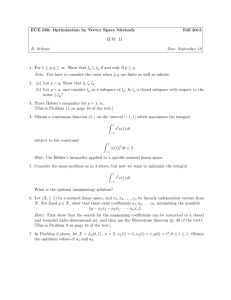
![MA3421 (Functional Analysis 1) Tutorial sheet 7 [November 20, 2014] Name: Solutions](http://s2.studylib.net/store/data/010731565_1-51ad01714c75b95d2b5f7e0d5655f78c-300x300.png)
